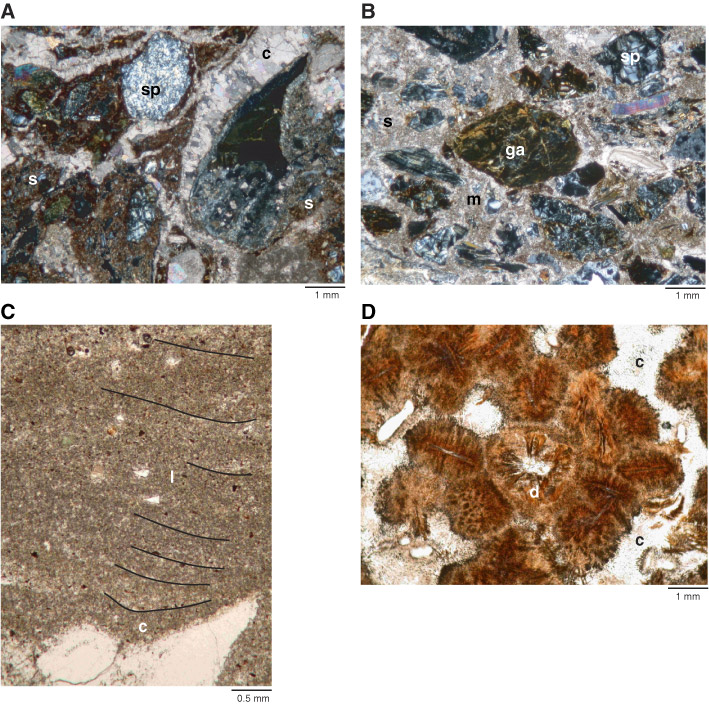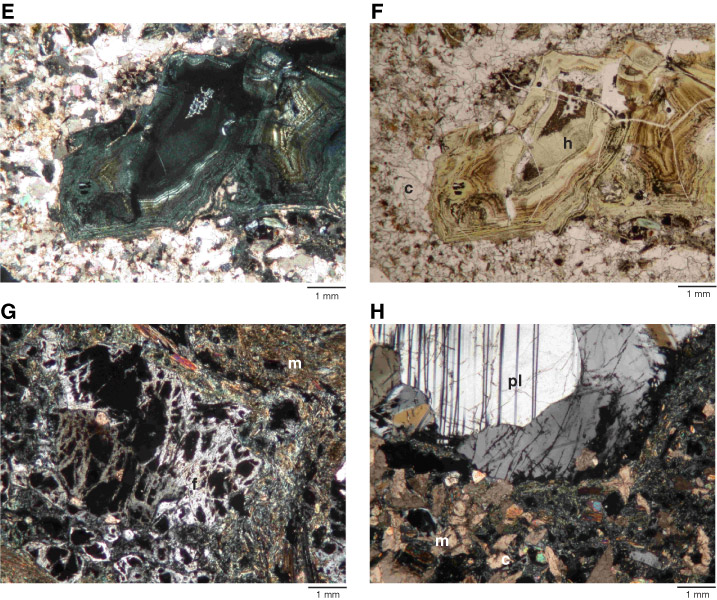
Figure F6. Photomicrographs of thin sections from the volcanic–sedimentary succession (Unit 1). Generalized stratigraphic positions are shown on Figure F3A. A. Breccia-conglomerate. Detrital grains of variably altered serpentinite (sp) within a matrix of ferruginous calc-siltite (s). The matrix was later cut by fractures that were infilled by calcite spar (c). The veins tend to avoid the detrital grains and are concentrated in the fine-grained matrix (Sample 210-1277A-3R-4, 86–89 cm; same thin section as in B). Cross-polarized light. B. Breccia-conglomerate. Detrital serpentinite grains (sp) within a calc-siltite matrix (s), partly replaced by calcite with altered volcanic glass (ga). m = micritic carbonate. Cross-polarized light. C. Calc-siltite fill of neptunian fissure showing subparallel lamination (l) and compaction (c) into small depressions between detrital grains. This sample is within coarse basalt-derived volcaniclastic sediment (see Fig. F5H). Note the relatively low angle of the primary laminations (<20°). The downward curvature of the laminations near the bottom is the result of differential compaction (Sample 210-1277A-3R-2, 105–108 cm). Plane-polarized light. D. Devitrified glass texture (d) within chilled selvage at the top of massive basalt Flow 2. Some calcite spar (c) is present (Sample 210-1277A-3R-2, 36–39 cm). E. Hyaloclastite surrounded by calcite spar within basaltic Flow 3 (Sample 210-1277A-3R-1, 7–9 cm; same thin section as F). Cross-polarized light. F. Hyaloclastite (h) within calcite spar (c) within basaltic Flow 3. The spar originated as a calc-siltite that was later partially recrystallized to calcite spar. Plane-polarized light. G. Sheared gabbro cataclasite. Very altered feldspar porphyroblast (f) within a sheared fine-grained chloritic matrix (m) that is partly replaced by calcite (Sample 210-1277A-2R-1, 91–94 cm). Cross-polarized light. H. Sheared gabbro cataclasite. Plagioclase porphyroblast (pl) within a sheared matrix (m) that is partly recrystallized to calcite spar (c) (Sample 210-1277A-2R-1, 91–94 cm. Cross-polarized light. Same thin section as G. I. Detrital serpentinite grains (sp) within calc-siltite (s) (Sample 210-1277A-2R-2, 59–62 cm). Cross-polarized light. J. Calcite spar (c) filling vein within calc-siltite (s). The calcite contains numerous grains of serpentinite (sp), mainly replaced by calcite spar (Sample 210-1277A-1W-2, 87–90 cm). Plane-polarized light. K. Internal carbonate silt (calc-siltite) (s) within hyaloclastites (h) that has undergone partial dissolution to create elongate cavities that were later infilled by prismatic carbonate spar (p) (Sample 210-1277A-1W-1, 101–104 cm). Plane-polarized light. L. Spalled hyaloclastite (h) and calc-siltite (s) (Sample 210-1277A-1W-2, 38–41 cm). Plane-polarized light. M. Calc-siltite (s) and hyaloclastites (h) within the uppermost basaltic Flow 4. The calc-siltite was partly dissolved and cemented by vug-filling calcite spar (c) (Sample 210-1277A-1W-2, 38–41 cm). N. Vein (fracture) in altered basalt clast, infilled with pink calc-siltite (s) (Sample 210-1277A-1W-1, 36–39 cm). Gently inclined lamination is visible. Cross-polarized light.







![]()